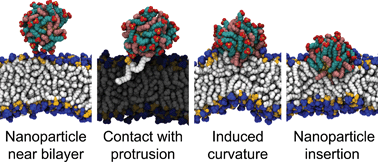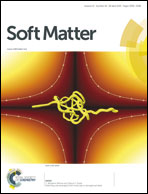Pathway for insertion of amphiphilic nanoparticles into defect-free lipid bilayers from atomistic molecular dynamics simulations†
Abstract
Gold nanoparticles (NPs) have been increasingly used in biological applications that involve potential contact with cellular membranes. As a result, it is essential to gain a physical understanding of NP-membrane interactions to guide the design of next-generation bioactive nanoparticles. In previous work, we showed that charged, amphiphilic NPs can fuse with lipid bilayers after contact between protruding solvent-exposed lipid tails and the NP monolayer. Fusion was only observed at the high-curvature edges of large bilayer defects, but not in low-curvature regions where protrusions are rarely observed. Here, we use atomistic molecular dynamics simulations to show that the same NPs can also fuse with low-curvature bilayers in the absence of defects if NP-protrusion contact occurs, generalizing the results of our previous work. Insertion proceeds without applying biasing forces to the NP, driven by the hydrophobic effect, and involves the transient generation of bilayer curvature. We further find that NPs with long hydrophobic ligands can insert a single ligand into the bilayer core in a manner similar to the binding of peripheral proteins. Such anchoring may precede insertion, revealing potential methods for engineering NP monolayers to enhance NP-bilayer fusion in systems with a low likelihood of lipid tail protrusions. These results reveal new pathways for NP-bilayer fusion and provide fundamental insight into behavior at the nano-bio interface.


 Please wait while we load your content...
Please wait while we load your content...